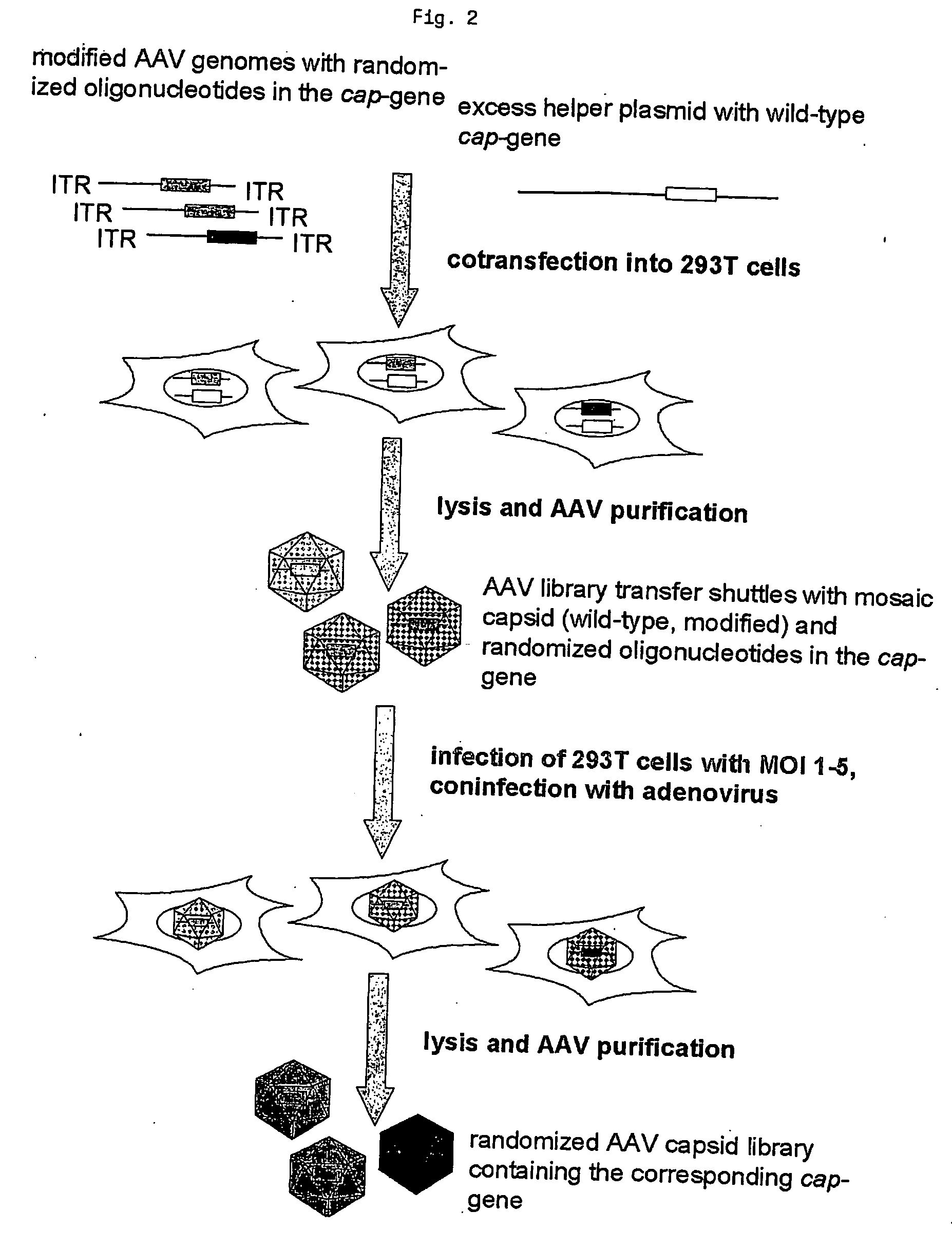Random peptide library displayed on aav vectors
a peptide library and vector technology, applied in the field of random peptide library displayed on aav vectors, can solve the problems of unintended transduction of certain tissues, adverse immune reactions, and uncertainty in the safety and efficacy of human gene therapy
- Summary
- Abstract
- Description
- Claims
- Application Information
AI Technical Summary
Benefits of technology
Problems solved by technology
Method used
Image
Examples
example 1
Materials and Methods
(A) Cell culture, transfection, virus production and titering.
[0056] Human coronary artery endothelial cells were maintained in the medium supplied by the cell provider (Promocell; Heidelberg, Germany). 293T and HeLa cells were maintained in Dulbecco's modified Eagle's medium with 10% fetal bovine serum (FBS). Transfections were performed by calcium phosphate precipitation (Hauswirth et al., Methods in Enzymology 316 (2000), 743-761). For production of AAV, we transfected 293T cells with the pTAV (Heilbronn et al., Virology 64 (1990), 3012-3018) or pSub201(Samulski et al., Journal of Virology 61 (1987), 3096-3101) plasmid, or their mutant derivatives, along with pXX6 (Xiao et al., Journal of Virology 72 (1998), 2224-2232) or pDG6VP (Dubielzig et al., Journal of Virology 73 (1999), 8989-8998), containing the adenovirus helper functions. After 72 h cells were harvested and viruses were purified by using iodixanol gradients (Hauswirth et al., 2000). Wild-type Ad...
example 2
Generation and Evaluation of AAV-2 Peptide Library Plasmids
[0064] An AAV-2 library based on the pMT187-0-3 backbone plasmid was designed to display a peptide with seven random amino acid residues within the VP capsid protein domain required for binding of AAV-2 to its natural receptor heparan sulfate (Wu et al., 2000; Xie et al., 2002); (FIG. 1A). The random peptide is flanked by two fixed amino acids, G and A (FIG. 1B). The diversity of the produced library plasmids was 1.1×108 clones per library as determined from analysis of the unamplified plasmid library. The DNA of 20 clones was sequenced to verify that different random peptides are encoded in each clone (data not shown). Two of these clones with the insert LHLNVAL or AALAGSL, respectively, were amplified individually as well as the insertless backbone plasmid. The library backbone was designed such that the oligonucleotide insertion is required to shift the reading frame back to the original as in the wild-type cap gene. Con...
example 3
Production of the random AAV-2 display peptide library
[0065] After establishing the plasmid library, the AAV particle library production was performed in two additional steps (FIG. 2). We reasoned that direct transfer of the plasmid library into AAV producer cells by using conventional DNA transfection procedures may lead to uptake of more than one library plasmid per producer cell with subsequent production of chimeric capsids displaying more than a single type of a peptide insert. In that case the packaged capsid gene would not encode the capsid mutants displayed on the viral surface, impeding the selection process and subsequent identification of selected capsid mutants. To avoid this problem, the library containing mutant cap genes were packaged into capsids made up partially of wild-type VP protein by cotransfecting wild-type rep-cap plasmids (pXX2) lacking the ITRs required for encapsidation (Li et al., Journal of Virology 71 (1997), 5236-5243) along with the AAV plasmid libr...
PUM
 Login to View More
Login to View More Abstract
Description
Claims
Application Information
 Login to View More
Login to View More - R&D
- Intellectual Property
- Life Sciences
- Materials
- Tech Scout
- Unparalleled Data Quality
- Higher Quality Content
- 60% Fewer Hallucinations
Browse by: Latest US Patents, China's latest patents, Technical Efficacy Thesaurus, Application Domain, Technology Topic, Popular Technical Reports.
© 2025 PatSnap. All rights reserved.Legal|Privacy policy|Modern Slavery Act Transparency Statement|Sitemap|About US| Contact US: help@patsnap.com



